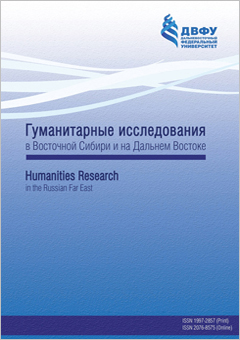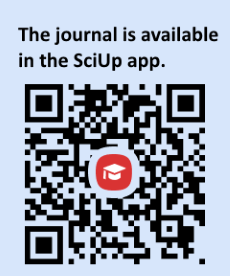Traditional national costume of the Ainu as a phenomenon of ethnic culture and as a museum exhibit
DOI:
https://doi.org/10.24866/1997-2857/2024-4/19-27Keywords:
Ainu, traditional national costume, ruunpe robe, museum exhibitAbstract
The article is devoted to the traditional national male costume of the Ainu, its main elements and accessories. Based on literary and visual sources, the author demonstrates changes in the composition of its elements that occurred at various historical stages, and characterizes its role in the life of a person and community. The article emphasizes the importance of the Ainu costume in the museum space not only as an artifact, but also as an object of research.
Downloads
References
1. Буссе Н.В. Остров Сахалин и экспедиция 1853–1854 гг. Дневник 25 августа 1853 г. – 19 мая 1854 г. Южно-Сахалинск: Южно-Сахалинское кн. изд-во, 2007. = Busse, N.V., 2007. Ostrov Sakhalin i ekspeditsiya 1853–1854 gg. Dnevnik 25 avgusta 1853 g. – 19 maya 1854 g. [Sakhalin Island and the Expedition of 1853–1854. Diary of August 25, 1853 – May 19, 1854.]. Yuzhno-Sahalinsk: Yuzhno-Sahalinskoe kn. izd-vo. (in Russ.)
2. Георги И.Г. Описание всех в Российском государстве обитающих народов, так же их житейских обрядов, вер, обыкновений, жилищ, одежд и прочих достопамятностей. Ч. 3. Семоядские, манджурские и восточные сибирские народы. СПб., 1777. = Georgi, J.G., 1777. Opisanie vsekh v Rossiiskom gosudarstve obitayushchikh narodov, tak zhe ikh zhiteiskikh obryadov, ver, obyknovenii, zhilishch, odezhd i prochikh dostopamyatnostei. Ch. 3. Semoyadskie, mandzhurskie i vostochnye sibirskie narody [Description of all the peoples living in the Russian state: their everyday rituals, customs, clothes, dwellings, exercises, amusements, faiths and other memorabilia. Part 3. About the peoples of Samoyad, Manchu and Eastern Siberian]. Sankt-Peterburg. (in Russ.)
3. Головачев В.Ц., Ивлиев А.Л., Певнов А.М., Рыкин П.О. Тырские стелы XV в. Перевод, комментарии, исследование китайских, монгольского и чжурчжэньского текстов. СПб.: Наука, 2011. = Golovachev, V.Тs., Ivliev, A.L., Pevnov, A.M. and Rykin, P.O., 2011. Tyrskie stely XV v.: perevod, kommentarii, issledovanie kitaiskikh, mongol’skogo i chzhurchzhen’skogo tekstov [The Tyr steles of the 15th century: translations, commentaries, study of the Chinese, Mongolian and Jurchen texts]. Sankt-Peterburg: Nauka. (in Russ.)
4. Грааф Т., Наарден Б. Описание нивхов и айнов и территорий их проживания в XVII веке по книге Н. Витсена «Северная и Восточная Тартария» // Краеведческий бюллетень. 2005. № 4. С. 3–62. = Graaf, T. and Naarden, B., 2005. Opisanie nivkhov i ainov i territorii ikh prozhivaniya v XVII veke po knige N. Vitsena «Severnaya i Vostochnaya Tartariya» [Description of the border areas of Russia with Japan and their inhabitants in Witsen’s «North and East Tartary»], Kraevedcheskii byulleten’, no. 4, pp. 3–62. (in Russ.)
5. Западноевропейские мореплаватели у берегов Сахалина и Курильских островов (XVII–XVIII вв.). Южно-Сахалинск: Лукоморье, 2010. = Zapadnoevropeiskie moreplavateli u beregov Sakhalina i Kuril’skikh ostrovov (XVII–XVIII vv.) [Sailors from Western Europe off the coast of Sakhalin and the Kuril Islands (17th and 18th centuries)]. Yuzhno-Sakhalinsk: Lukomor’e. (in Russ.)
6. Лим С.Ч. История сопротивления айнского народа и государственная политика Японии (XV – начало ХХ вв.). Владивосток: Изд-во ДВФУ, 2013. = Lim, S.Ch., 2013. Istoriya soprotivleniya ainskogo naroda i gosudarstvennaya politika Yaponii (XV – nachalo XX vv.) [The history of Ainu resistance and the state policy of Japan (15th – early 20th century)]. Vladivostok: Izd-vo DVFU. (in Russ.)
7. Нихон сёки. Анналы Японии. Т. I. Свиток VII. URL: https://www.vostlit.info/Texts/Dokumenty/Japan/VIII/720-740/Nihon_seki_I/frametext7.htm = Nikhon seki. Annaly Yaponii. T. I. Svitok VII [Nihon Shoki. Annals of Japan. Vol. I. Scroll VII]. URL: https://www.vostlit.info/Texts/Dokumenty/Japan/VIII/720-740/Nihon_seki_I/frametext7.htm (in Russ.)
8. Осипова М.В. Визуальный образ айнов в живописных работах и гравюрах XVI – начала XIX в.: историко-этнографический источник или художественный вымысел? // Этнографическое обозрение. 2023. № 3. С. 187–205. = Osipova, M.V., 2023. Vizual’nyi obraz ainov v zhivopisnykh rabotakh i gravyurakh XVI – nachala XIX v.: istoriko-etnograficheskii istochnik ili khudozhestvennyi vymysel? [Visual image of the Ainu in paintings and engravings of the 16th – early 19th centuries: historical and ethnographic source or artist’s imagination?], Etnograficheskoe obozrenie, no. 3, рр.187–205. (in Russ.)
9. Рекомендации Комитета музеев и коллекций костюма Международного совета музеев по хранению костюма. URL: https://costume.mini.icom.museum/wpcontent/uploads/sites/10/2018/12/-guidelines_russian.pdf = Rekomendatsii Komiteta muzeev i kollektsii kostyuma Mezhdunarodnogo soveta muzeev po khraneniyu kostyuma [ICOM International Committee for Museums and Collections of Costume guidelines]. URL: https://costume.mini.icom.museum/wp-content/uploads/sites/10/2018/12/guidelines_russian.pdf (in Russ.)
10. Соколов А.М. Айны: от истоков до современности. Материалы к истории становления айнского этноса. СПб.: МАЭ РАН, 2014. = Sokolov, A.M., 2014. Ainy: ot istokov do sovremennosti [Ainu: from the origin to present]. Sankt-Peterburg: MAE RAN. (in Russ.)
11. Соколов А.М. Пламенеющие клинки айнов. СПб.: МАЭ РАН, 2022. = Sokolov, A.M., 2022. Plameneyushchie klinki ainov [The flaming blades of Ainu]. Sankt-Peterburg: MAE RAN. (in Russ.)
12. Хаяси Сётаро. Декоративно-прикладное искусство племени айну // Айну когэй – Сахарин айну сэйкацу бунка. Саппоро: Айну бунка синко кэнкю суисин кико, 1998. С. 14–15. = Hayashi Shotaro, 1998. Dekorativno-prikladnoe iskusstvo plemeni ainu [The сrafts of Ainu]. In: アイヌ工芸 – サハリンアイヌ生活文化. 札幌市: アイヌ文化振興・研究推進機構, 1998, pp. 14–15. (in Russ.)
13. Хокон С.Э., Сиюхова А.М. Этнокостюм как концепт культуросоциологического знания // Вестник Саратовского государственного технического университета. 2014. № 1. С. 144–149. = Khokon, S.E. and Siyukhova, A.M., 2014. Etnokostyum kak kontsept kul’turosotsiologicheskogo znaniya [Ethnic costume as a concept of cultural and sociological knowledge], Vestnik Saratovskogo gosudarstvennogo tekhnicheskogo universiteta, no. 1, pp. 144–149. (in Russ.)
14. Щепкин В.В. Айны глазами японцев: неизвестная коллекция А.В. Григорьева. СПб.: Арка, 2022. = Shchepkin, V.V., 2022. Ainy glazami yapontsev: neizvestnaya kollektsiya A.V. Grigor’eva [Ainu through the eyes of the Japanese: the unknown collection of A.V. Grigoriev]. Sankt-Peterburg: Arka. (in Russ.)
15. Batchelor, J., 1892. The Ainu of Japan: the religion, superstitions, and general history of the hairy aborigines of Japan. London: Religious Tract Society.
16. Batchelor, J., 1901. The Ainu and their folklore. London: Religious Tract Society.
17. Hitchcock, R. The Ainos of Yezo, Japan. In: Annual report of the Board of regents of the Smithsonian Institution for the year ending June 30, 1890. Washington: Government Printing Office, 1891, pp. 429–502.
18. Landor, A.H., 1893. Alone with the hairy Ainu, Or 3,800 miles on a pack saddle in Yezo and a cruise to the Kurile Islands. London: John Murray.
19. Sasaki, T., 1993. On Ainu-e: pictorial descriptions of Ainu life and customs. In: Kreiner, J. ed., 1993. European studies on Ainu language and culture. München: Iudicium Verlag, pp. 217–227.
20. Siddle, R.M., 1996. Race, resistance, and the Ainu of Japan. New York: Routledge.
21. Torntore, S.J., 2004. Fashion, tradition, and cultural authentication: change in Hmong American ethnic textiles and aesthetics at Hmong New Year. Textile Society of America Symposium Proceedings, no. 441, pp. 118–123.
22. Араи Хакусэки. Эдзо си (Описание Эдзо). URL: https://digital.library.wisc.edu/1711.dl/3yq7hoqb5zjft9c = 新井白石. 蝦夷志 [Ezo-shi]. URL: https://digital.library.wisc.edu/1711.dl/3YQ7HOQB5ZJFT9C (in Japanese)
23. Китахара Дзирота. «Синри цуресипа» (Сосэн но кураси). 15. Айну но ифуку бунка («Жизнь предков». 15. Культура одежды айнов). URL: https://ainugo.nam.go.jp/siror/monthly/201606.html = 北原次郎太. «シンリッウレシパ» (祖先の暮らし). 15. アイヌの衣服文化 [«Shinri ureshipa» (The Life of Ancestors). 15. Ainu clothing culture]. URL: https://ainugo.nam.go.jp/siror/monthly/201606.html (in Japanese)
24. Огихара Cинко. Айну бунка ни океру токэн ни кансуру обоэгаки (Мечи в культуре айнов) // Тиба дайгаку юрася гэнго бунка ронсю. 2007. № 10. С. 21–24. = 荻原真子, 2007. アイヌ文化における刀剣に関する覚書 [A note on swords in Ainu Culture], 千葉大学ユーラシア言語文化論集, no. 10, pp. 21–24. (in Japanese)
25. Эмори Сусуму. Айну миндзоку но рэкиси (История айнов). Токио: Софукан, 2007. = 榎森進, 2007. アイヌ民族の歴史 [History of the Ainu People]. 東京: 草風館. (in Japanese)
Downloads
Published
Issue
Section
License
Copyright (c) 2024 Марина Викторовна Осипова

This work is licensed under a Creative Commons Attribution-NonCommercial-NoDerivatives 4.0 International License.












